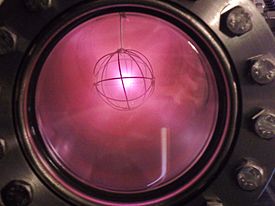
Back الحبس الكهروستاتيكي بالقصور الذاتي Arabic Elektrostatischer Trägheitseinschluss German محصورسازی الکترواستاتیکی اینرسی Persian Confinement inertiel électrostatique French 慣性静電閉じ込め核融合 Japanese Inercyjne uwięzienie elektrostatyczne plazmy Polish Электростатическое удержание плазмы Russian 惯性静电约束 Chinese

Inertial electrostatic confinement, or IEC, is a class of fusion power devices that use electric fields to confine the plasma rather than the more common approach using magnetic fields found in magnetic confinement fusion (MCF) designs. Most IEC devices directly accelerate their fuel to fusion conditions, thereby avoiding energy losses seen during the longer heating stages of MCF devices. In theory, this makes them more suitable for using alternative aneutronic fusion fuels, which offer a number of major practical benefits and makes IEC devices one of the more widely studied approaches to fusion.
As the negatively charged electrons and positively charged ions in the plasma move in different directions in an electric field, the field has to be arranged in some fashion so that the two particles remain close together. Most IEC designs achieve this by pulling the electrons or ions across a potential well, beyond which the potential drops and the particles continue to move due to their inertia. Fusion occurs in this lower-potential area when ions moving in different directions collide. Because the motion provided by the field creates the energy levels needed for fusion, not random collisions with the rest of the fuel, the bulk of the plasma does not have to be hot and the systems as a whole work at much lower temperatures and energy levels than MCF devices.
One of the simpler IEC devices is the fusor, which consists of two concentric metal wire spherical grids. When the grids are charged to a high voltage, the fuel gas ionizes. The field between the two then accelerates the fuel inward, and when it passes the inner grid the field drops and the ions continue inward toward the center. If they impact with another ion they may undergo fusion. If they do not, they travel out of the reaction area into the charged area again, where they are re-accelerated inward. Overall the physical process is similar to the colliding beam fusion, although beam devices are linear instead of spherical. Other IEC designs, like the polywell, differ largely in the arrangement of the fields used to create the potential well.
A number of detailed theoretical studies have pointed out that the IEC approach is subject to a number of energy loss mechanisms that are not present if the fuel is evenly heated, or "Maxwellian". These loss mechanisms appear to be greater than the rate of fusion in such devices, meaning they can never reach fusion breakeven and thus be used for power production. These mechanisms are more powerful when the atomic mass of the fuel increases, which suggests IEC also does not have any advantage with aneutronic fuels. Whether these critiques apply to specific IEC devices remains highly contentious.
© MMXXIII Rich X Search. We shall prevail. All rights reserved. Rich X Search